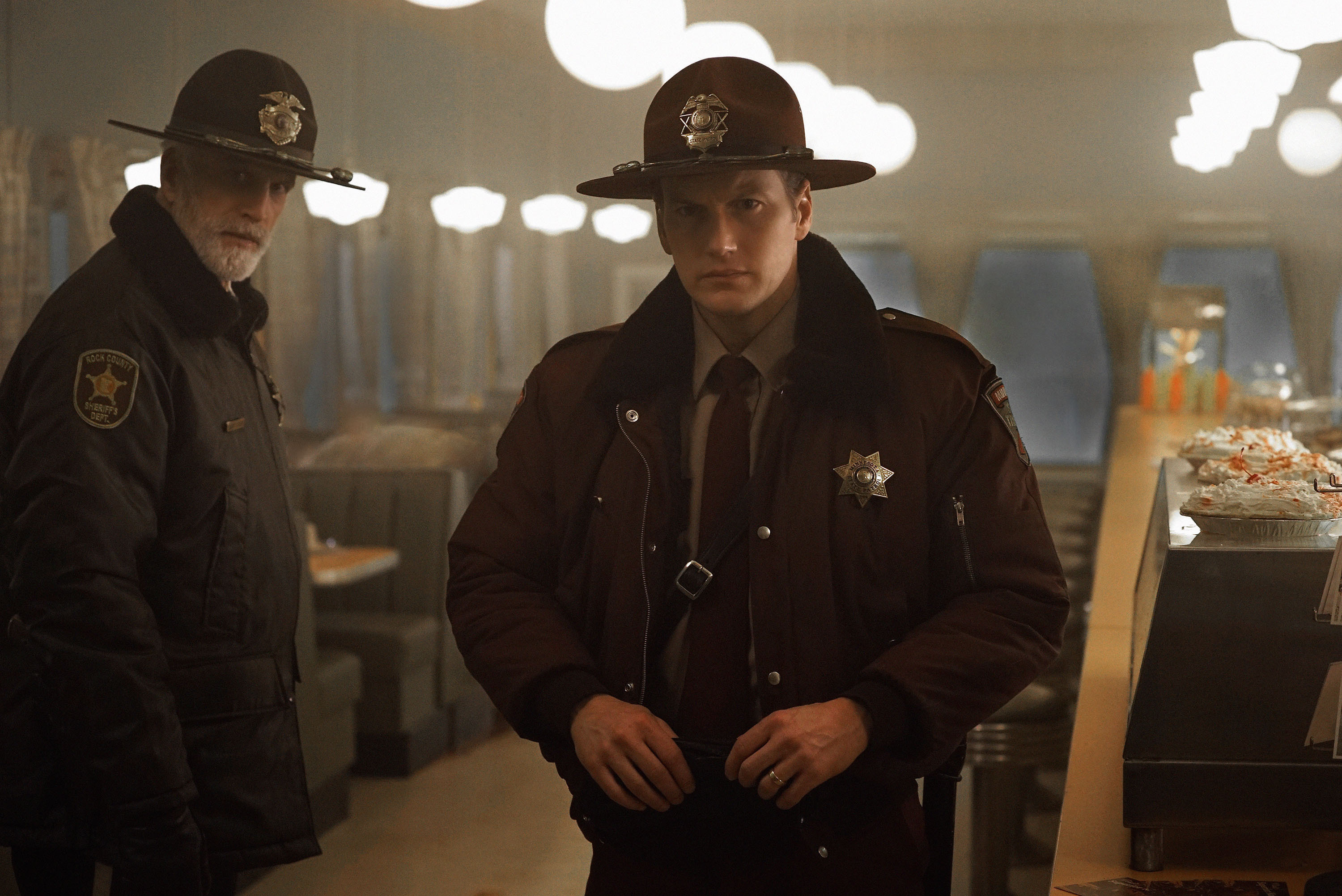Minnesota Nice vs. Evil: The moral universe of FX's remarkable Fargo
Does the season two premiere of the acclaimed FX drama live up to the hype? You betcha.


"This is a true story."
That's the title card that opens every episode of FX's Fargo. It's a gag borrowed from the Coen Brothers, who used the same sentence to open their Oscar-nominated Minnesota noir in 1996 — a time your average viewer couldn't just Google "wood chipper murder" and discover that the whole thing was a work of fiction.
Today, viewers of FX's adaptation-prequel-sequel to Fargo are much less likely to be fooled, even though the new season offers another mesmerizing crime story in the frigid plains of Minnesota.
The Week
Escape your echo chamber. Get the facts behind the news, plus analysis from multiple perspectives.

Sign up for The Week's Free Newsletters
From our morning news briefing to a weekly Good News Newsletter, get the best of The Week delivered directly to your inbox.
From our morning news briefing to a weekly Good News Newsletter, get the best of The Week delivered directly to your inbox.
The second season solidifies Fargo as the perfect hybrid of the one-and-done anthology series (as seen in shows like True Detective and American Horror Story) and traditional multi-season story arcs (as seen in Game of Thrones, Breaking Bad, and pretty much every other acclaimed TV drama released over the past decade).
Fargo's two seasons exist within the same continuity — and, in fact, in the same continuity as the original Coen Brothers film. But the two seasons are separated by a gulf of 27 years, which allows the show to tell a brand-new story set in the past with a brand-new cast. By the end of the first hour, we've met most of the second season's key players: a half-dozen members of the Gerhardt clan, a crime family with a stranglehold on a significant patch of North Dakota; Ed and Peggy Blomquist (Jesse Plemons and Kirsten Dunst), a married couple who cover up a near-fatal hit-and-run; and Minnesota State Trooper Lou Solverson (Patrick Wilson), who's tasked with unraveling an exceedingly complicated knot of crimes.
To Fargo veterans, that last name might sound familiar. To be clear: If you haven't seen Fargo's first season, there's absolutely nothing you won't comprehend about the second. (Except, perhaps, that UFO in the sky — but no one can really help you there.) That said: If you have seen Fargo's first season, the new scenes featuring Lou Solverson — the retired cop turned diner owner played by Keith Carradine in season one — will have an extra kick of sentimentality. Viewed in the series' full context, a seemingly innocuous scene like Lou reading a children's book to his 4-year-old daughter will feel heartbreakingly poignant to those who first met her as 33-year-old deputy Molly Solverson (Allison Tolman), the pillar of morality and courage who anchored Fargo's first season.
Fargo's second season is centered on 1979's "Sioux Falls incident," which was briefly referred to by Lou in season one. "I saw something that year I ain't ever seen, before or since. I'd call it animal. Except animals only kill for food," he says, clearly disturbed by the memory, in conversation with Molly. The season two premiere sets many stories in motion, but each one is connected through the bloody Sioux Falls incident: a massacre at a 24-hour Waffle Hut that leaves a waitress, a cook, and a judge dead.
A free daily email with the biggest news stories of the day – and the best features from TheWeek.com
We've already met the killer: Rye Gerhardt (Kieran Culkin). The Gerhardt family has a lock on the trucking and distribution industries in the upper Midwest — but if they're the Minnesota equivalent of the Corleones, Rye is the Fredo. Rye is a frustrated hustler at the bottom of his family's hierarchy in both age and respect, and he decides to strike out on his own. Unfortunately, he does it by teaming up with a hard-luck typewriter salesman, who swears he could corner the market — and cut Rye into the deal — if he could just get a judge off his back.
Rye follows the judge to the Waffle Hut in Luverne, Minnesota, doing an extra bump of coke for courage before he confronts her. But when he actually threatens the judge, she rolls her eyes. "If the devil couldn't change Job's mind, how the hell are you gonna change mine?" she asks. When he realizes he can't, Rye pulls out a gun and shoots her instead.
The biblical reference, which places the series' moral struggle into a much grander framework, is well chosen. Look beyond the hand-knit sweaters and the aw-shucks accents, and you'll see that the Fargo universe is a place where "Minnesota nice" provides a convenient cover for some of the state's darker, more venal residents. In the film, it was Jerry Lundegaard (William H. Macy), a failed businessman who plans his own wife's kidnapping to score a little extra cash. In season one, it was Lester Nygaard (Martin Freeman), a milquetoast pushover whose seething inner powder keg is ignited by a chance encounter with a stranger. And in season two, it's Peggy Blomquist (Kirsten Dunst), who hits a man with her car and keeps on driving — eventually dumping his body in her garage while she cooks up some Hamburger Helper for dinner.
Fargo cuts away right after Peggy crashes into Rye — just moments after he shot up the diner and fled into the snow — so we don't know how quickly she decided what to do about it. But we know, through implication, that Peggy drove home while Rye, bleeding out, was stuck in her windshield. We know that Peggy sat down for dinner with her husband while Rye was bleeding to death nearby. And we know that Peggy continued to lie — about hitting a deer, about the person in her garage, and about believing her victim was dead — until Rye literally rises up from the shadows, like a cornered animal, and attacks her husband.
Peggy is a sociopath in the vein of Fargo's previous sociopaths. Her coldness and narcissism have already led to dire consequences for both her victim and her husband, who ends up killing Rye in the heat of a short struggle. But the body hasn't even cooled before she starts scheming a way they can escape any consequences. "We'll start again," she says, proposing they pick up and move to California. "Pretend it didn't happen."
But rest assured: However long she slips out of the noose, Peggy will face some form of justice in the end. As an anthology series, Fargo has drawn mountains of comparisons to HBO's True Detective — but in both story structure and themes, the series has much more in common with AMC's Breaking Bad, which turned on a similar sense of cosmic morality. Fargo's first season cast its central villain, Lorne Malvo (Billy Bob Thornton), as a kind of trickster god on a rampage through Minnesota, spreading chaos everywhere he goes. Under Malvo's tutelage, meek Lester Nygaard (Martin Freeman) becomes a ruthless and shameless killer. "Your problem is you spent your whole life thinking there are rules," says Malvo, prodding Lester into breaking bad. "There aren't."
It's a darkly seductive speech — but by the end of the first season, Fargo proves Lorne Malvo wrong. There are rules; legal, yes, but also moral. If the villains of Fargo use "Minnesota nice" as a shield to disguise their narcissism and cruelty, the heroes of Fargo — Marge Gunderson (Frances McDormand), Molly Solverson, and her father Lou — use it as a sword to attack the greed and cynicism of criminality.
And that brings us back to the epigrammatic phrase "this is a true story." In the climactic speech of 1996's Fargo, Marge Gunderson laments the senselessness of the violence that has taken place over the course of the film. "There's more to life than money, you know," she says to the movie's most merciless criminal, now handcuffed in the back of her car. "Don'tcha know that? And here ya are. And it's a beautiful day."
The fact that Marge gives this "beautiful day" speech in the middle of a blizzard doesn't make her an idiot. It makes her a hero. It's the heroism of optimism — an active decision to look at a cold, lifeless world, both literally and metaphorically, and will goodness into being.
And that's what makes each story set in the ever-expanding Fargo universe so powerful. No, the events depicted may not have literally happened — but the series' real backbone is a kind of moral truth all the same.
Scott Meslow is the entertainment editor for TheWeek.com. He has written about film and television at publications including The Atlantic, POLITICO Magazine, and Vulture.
-
 Nigel Farage: was he a teenage racist?
Nigel Farage: was he a teenage racist?Talking Point Farage’s denials have been ‘slippery’, but should claims from Reform leader’s schooldays be on the news agenda?
-
 Pushing for peace: is Trump appeasing Moscow?
Pushing for peace: is Trump appeasing Moscow?In Depth European leaders succeeded in bringing themselves in from the cold and softening Moscow’s terms, but Kyiv still faces an unenviable choice
-
 Sudoku medium: November 29, 2025
Sudoku medium: November 29, 2025The daily medium sudoku puzzle from The Week
